The Hubble Deep Field Survey
The Hubble Space Telescope spent 10 days in December 1995 observing a single tiny patch of sky near the Big Dipper. These observations resulted in the deepest image of the sky, called the Hubble Deep Field (HDF), revealing galaxies fainter than had ever been seen before. The striking full-color image of the distant universe was unveiled at the American Astronomical Society Meeting in January 1996.
"The variety of galaxies we see is amazing. In time these Hubble data could turn out to be the double helix of galaxy formation. We are clearly seeing some of the galaxies as they were more than ten billion years ago, in the process of formation. As the images have come up on our screens, we have not been able to keep from wondering if we might somehow be seeing our own origins in all of this." -- Robert Williams, Director, Space Telescope Science Institute (STScI), Baltimore, Maryland
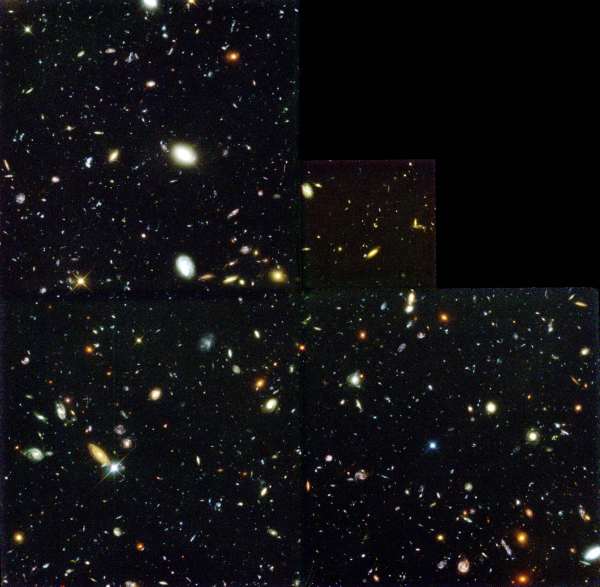
Hubble's Deepest View of the Universe
Unveils Myriad Galaxies Back to the Beginning of Time
Several hundred never before seen galaxies are visible in this "deepest-ever" view of the universe, called the Hubble Deep Field (HDF), made with NASA's Hubble Space Telescope. Besides the classical spiral and elliptical shaped galaxies, there is a bewildering variety of other galaxy shapes and colors that are important clues to understanding the evolution of the universe. Some of the galaxies may have formed less that one billion years after the Big Bang.
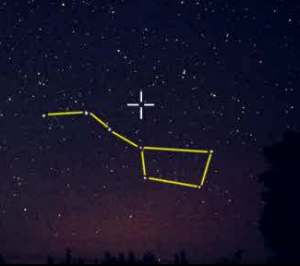
Representing a narrow "keyhole" view all the way to the visible horizon of the universe, the HDF image covers a speck of sky 1/30th the diameter of the full Moon near Ursa Major (the Big Dipper). This is so narrow, just a few foreground stars in our Milky Way galaxy are visible and are vastly outnumbered by the menagerie of far more distant galaxies, some nearly as faint as 30th magnitude, or nearly four billion times fainter than the limits of human vision. (The relatively bright object with diffraction spikes just left of center may be a 20th magnitude star.) Though the field is a very small sample of sky area it is considered representative of the typical distribution of galaxies in space because the universe, statistically, looks the same in all directions.
The image was assembled from many separate exposures (342 frames total were taken, 276 have been fully processed to date and used for this picture) with the Wide Field and Planetary Camera 2 (WFPC2), for ten consecutive days between December 18 to 28, 1995. This picture is from one of three wide-field CCD (Charged Coupled Device) detectors on the WFPC2.
This "true-color" view was assembled from separate images were taken in blue, red, and infrared light. By combining these separate images into a single color picture, astronomers will be able to infer -- at least statistically -- the distance, age, and composition of galaxies in the field. Bluer objects contain young stars and/or are relatively close, while redder objects contain older stellar populations and/or farther away.
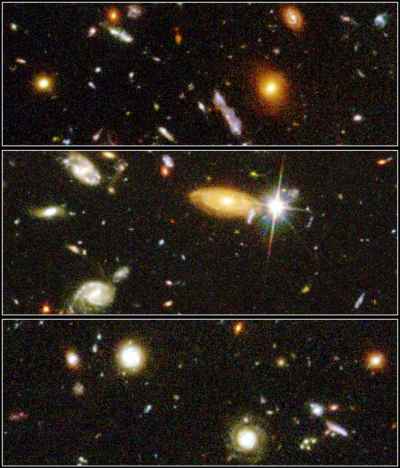
Sample Galaxies From the Hubble Deep Field
These three images represent select portions of the sky as seen in the Hubble Deep Field observation -- the "deepest-ever" view of the universe, made with NASA's Hubble Space Telescope.
The images, extracted from the Hubble Deep Field (HDF), were assembled from many separate exposures (342 frames total were taken, 276 have been fully processed to date and used for this picture) with the Wide Field and Planetary Camera 2 (WFPC2), for ten consecutive days between December 18 to 28, 1995.
Besides the classical spiral- and elliptical-shaped galaxies, there is a bewildering variety of other galaxy shapes and colors. The never before seen dimmest galaxies are nearly 30th magnitude.
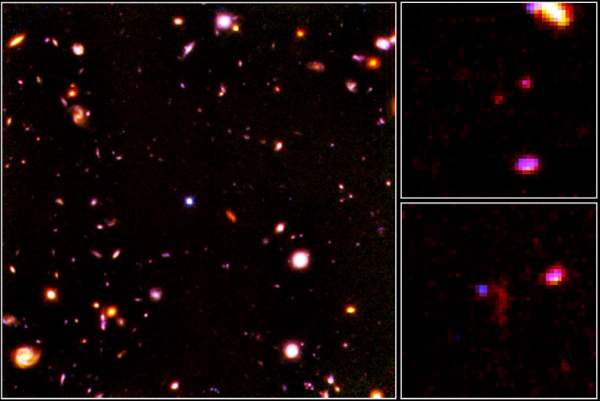
The Deep Field in Infrared
[Left]
A NASA Hubble Space Telescope view of the faintest galaxies ever seen in the universe, taken in infrared light with the Near Infrared Camera and Multi-Object Spectrometer (NICMOS).
The picture contains over 300 galaxies having spiral, elliptical and irregular shapes. Though most of these galaxies were first seen in 1995 when Hubble was used to take a visible-light deep exposure of the same field, NICMOS uncovers many new objects. Most of these objects are too small and faint to be apparent in the full field NICMOS view.
Some of the reddest and faintest of the newly detected objects may be over 12 billion light-years away, as derived from a standard model of the universe. However, a powerful new generation of telescopes will be needed to confirm the suspected distances of these objects.
The field of view is 2 million light-years across, at its maximum. Yet, on a cosmic scale, it represents only a thin pencil beam look across the universe. The area of sky is merely 1/100th the apparent diameter on the full moon.
[Right]
Two close-up NICMOS views of candidate objects which may be over 12 billion light-years away. Each candidate is centered in the frame. The reddish color may mean all of the starlight has been stretched to infrared wavelengths by the universe's expansion. Alternative explanations are that the objects are closer to us, but the light has been reddened by dust scattering. A new generation of telescopes will be needed to make follow-up observations capable of establishing true distance.
The image was taken in January 1998 and required an exposure time of 36 hours to detect objects down to 30th magnitude. The color corresponds to blue (0.45 microns), green (1.1 microns) and red (1.6 microns).
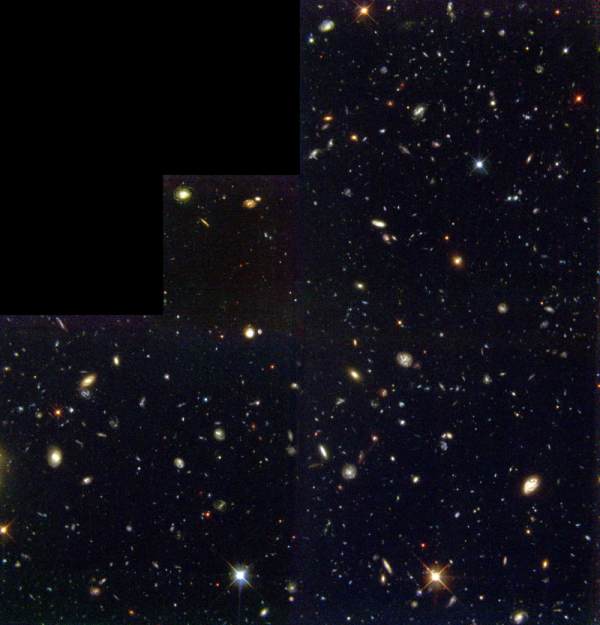
Hubble Deep Field South Unveils Myriad Galaxies
A NASA Hubble Space Telescope view down a 12 billion light-year long corridor of space loaded with a dazzling assortment of thousands of never-before seen galaxies.
This picture is the culmination of a 10-day-long observation called the Hubble Deep Field South (HDF-S) which was carried out in October 1998 by a team of astronomers at the Space Telescope Science Institute (STScI) and the Goddard Space Flight Center.
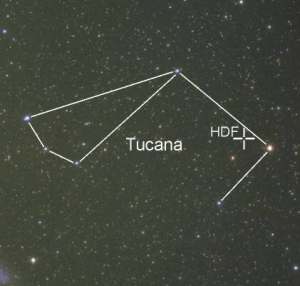
This new "far-look" complements the original Hubble "deep field" taken in late 1995, when Hubble was aimed at a small patch of space near the Big Dipper. The new region is in the constellation Tucana, near the south celestial pole.
Hubble’s sharp vision allows astronomers to sort galaxy shapes. The image is dominated by beautiful pinwheel-shaped disk galaxies, which are like our Milky Way. The picture also contains a variety of peculiar-shaped galaxies that are in collision with companion galaxies. Elliptical galaxies appear as reddish blobs. A sprinkling of foreground stars (belonging to our Milky Way) appear as bright points with "diffraction spikes" an artifact of all telescope optics.
The colors in the pictures are a natural representation of the galaxies’ stellar populations. Blue corresponds to young hot stars. Red may indicate older stars, starlight scattered by dust, or very distant starlight that has been stretched to redder wavelengths by the universe’s expansion.
Follow-up observations with large ground-based telescopes in the southern hemisphere will establish the distances to the galaxies. This will help astronomers understand the history of the universe because the galaxies represent the universe at different epochs, depending on their distances.
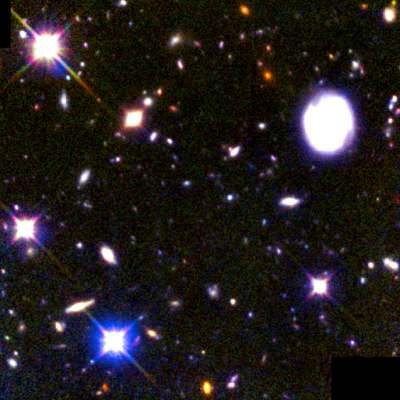
Combined Deep View of Infrared and Visible Light Galaxies
This narrow, deep view of the universe reveals a plethora of galaxies (reaching fainter than 28th magnitude), as seen in visible and infrared light by NASA’s Hubble Space Telescope. The reddish galaxies are glowing in infrared light, and the bluish galaxies are glowing in visible light. Several distinctive types of galaxies can be seen in these views: blue dwarf galaxies, disk galaxies, and very red elliptical galaxies. A bright, nearby face-on spiral galaxy appears at upper right. Some of the brightest objects in the field are foreground stars in the halo of our own Milky Way galaxy. By combining views in infrared light and visible light astronomers have a better idea of the shapes of galaxies in the remote universe, and of the fraction which are old or dust-obscured at early epochs.
Galaxies could appear bright in the infrared (and thus red in this picture) for several reasons. They might be dusty, or contain old stars, or are at a very great distance. Several of the red galaxies in this field have the colors and the smooth, symmetric shapes expected for old elliptical galaxies. The existence of such objects in the early universe and their numbers can set important limits on the era when the earliest galaxies assembled and formed most of their stars. In general, the image shows that the shapes and sizes of most faint galaxies are similar in infrared and visible light, suggesting that younger and older stars within distant galaxies are well mixed and that dust is not completely distorting impressions of distant objects.
The image was taken in October 1998 as part of the Hubble Deep Field South imaging campaign. It is in a small patch of sky in the constellation Tucana. The false-color image is a composite of separate images taken with the NICMOS and STIS cameras on board the Hubble Space Telescope. The red and green colors correspond to infrared wavelengths of 1.6 and 1.1 microns, respectively. The blue color corresponds to the STIS view that covers the full range of visible wavelengths.
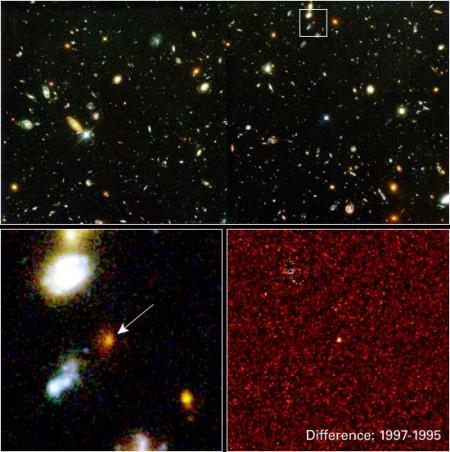
The Most Distant Supernova Ever Seen
Using NASA's Hubble Space Telescope, astronomers pinpointed a blaze of light from the farthest supernova ever seen, a dying star that exploded 10 billion years ago.
The detection and analysis of this supernova, called 1997ff, is greatly bolstering the case for the existence of a mysterious form of dark energy pervading the cosmos, making galaxies hurl ever faster away from each other. The supernova also offers the first glimpse of the universe slowing down soon after the Big Bang, before it began speeding up.
This panel of images, taken with the Wide Field and Planetary Camera 2, shows the supernova's cosmic neighborhood; its home galaxy; and the dying star itself.
Astronomers found this supernova in 1997 during a second look at the northern Hubble Deep Field [top panel], a tiny region of sky first explored by the Hubble telescope in 1995. The image shows the myriad of galaxies Hubble spied when it peered across more than 10 billion years of time and space. The white box marks the area where the supernova dwells.
The photo at bottom left is a close-up view of that region. The white arrow points to the exploding star's home galaxy, a faint elliptical. Its redness is due to the billions of old stars residing there.
The picture at bottom right shows the supernova itself, distinguished by the white dot in the center. Although this stellar explosion is among the brightest beacons in the universe, it could not be seen directly in the Hubble images. The stellar blast is so distant from Earth that its light is buried in the glow of its host galaxy.
To find the supernova, astronomers compared two pictures of the "deep field" taken two years apart. One image was of the original Hubble Deep Field; the other, the follow-up deep-field picture taken in 1997. Using special computer software, astronomers then measured the light from the galaxies in both images. Noting any changes in light output between the two pictures, the computer identified a blob of light in the 1997 picture that wasn't in the original deep-field study. That blob turned out to be the supernova. The red background texture is an artifact of the process of isolating the supernova.
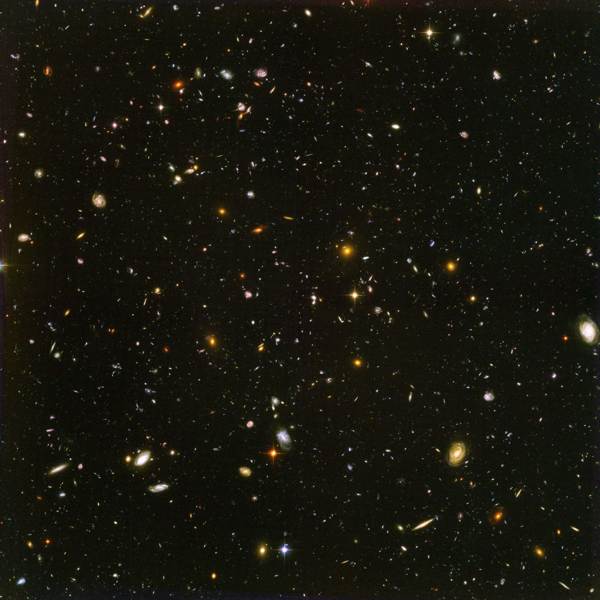
The Hubble Ultra Deep Field
Galaxies, galaxies everywhere - as far as NASA's Hubble Space Telescope can see. This view of nearly 10,000 galaxies is the deepest visible-light image of the cosmos. Called the Hubble Ultra Deep Field, this galaxy-studded view represents a "deep" core sample of the universe, cutting across billions of light-years.
The snapshot includes galaxies of various ages, sizes, shapes, and colors. The smallest, reddest galaxies, about 100, may be among the most distant known, existing when the universe was just 800 million years old. The nearest galaxies - the larger, brighter, well-defined spirals and ellipticals - thrived about 1 billion years ago, when the cosmos was 13 billion years old.
In vibrant contrast to the rich harvest of classic spiral and elliptical galaxies, there is a zoo of oddball galaxies littering the field. Some look like toothpicks; others like links on a bracelet. A few appear to be interacting. These oddball galaxies chronicle a period when the universe was younger and more chaotic. Order and structure were just beginning to emerge.
The Ultra Deep Field observations, taken by the Advanced Camera for Surveys, represent a narrow, deep view of the cosmos. Peering into the Ultra Deep Field is like looking through an eight-foot-long soda straw.
In ground-based photographs, the patch of sky in which the galaxies reside (just one-tenth the diameter of the full Moon) is largely empty. Located in the constellation Fornax, the region is so empty that only a handful of stars within the Milky Way galaxy can be seen in the image.
In this image, blue and green correspond to colors that can be seen by the human eye, such as hot, young, blue stars and the glow of Sun-like stars in the disks of galaxies. Red represents near-infrared light, which is invisible to the human eye, such as the red glow of dust-enshrouded galaxies.
The image required 800 exposures taken over the course of 400 Hubble orbits around Earth. The total amount of exposure time was 11.3 days, taken between Sept. 24, 2003 and Jan. 16, 2004.
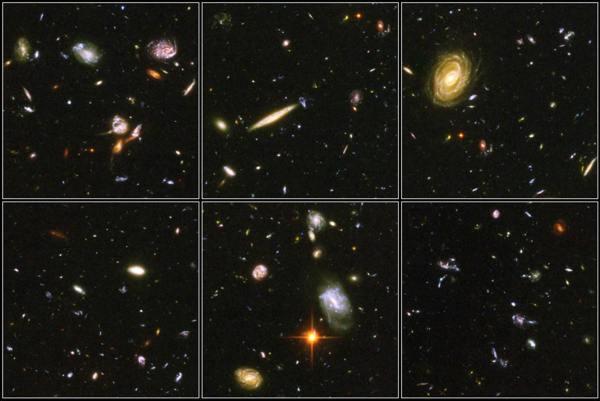
Galactic Drama in Ultra Deep Field Details
A galactic brawl. A close encounter with a spiral galaxy. Blue wisps of galaxies. These close-up snapshots of galaxies in the Hubble Ultra Deep Field reveal the drama of galactic life.
Almost every panel shows oddball-shaped galaxies engaged in boxing matches with galactic neighbors. In the panel at top, left, three galaxies just below center are enmeshed in battle, their shapes distorted by the brutal encounter. The panel at top, center, reveals an edge-on spiral galaxy fending off a weirdly shaped blue galaxy. The panel at bottom, right, is littered with close encounters between galaxies that have been shredded by the interactions. These oddball galaxies chronicle a period when the universe was younger and more chaotic. Order and structure were just beginning to emerge.
Not all the galaxies are engaged in galactic mayhem. In the panel at top, right, is a majestic spiral galaxy, one of the nearest galaxies in the Ultra Deep Field. This galaxy existed about 1 billion years ago, when the cosmos was 13 billion years old. The smallest, reddest galaxies [the red dots in the panels at top, left and bottom, left] may be among the most distant known, existing when the cosmos was 800 million years old.
The galaxies in these panels were plucked from a harvest of nearly 10,000 galaxies in the Ultra Deep Field, the deepest visible-light image of the cosmos.
The Ultra Deep Field observations, taken by the Advanced Camera for Surveys, represent a narrow, "deep" view of the cosmos. Peering into the Ultra Deep Field is like looking through an eight-foot-long soda straw.
In ground-based images, the patch of sky in which the galaxies reside (just one-tenth the diameter of the full Moon) is largely empty. Located in the constellation Fornax, the region is so empty, in fact, that only a handful of stars within the Milky Way galaxy can be seen in the image.
In this image, blue and green correspond to colors that can be seen by the human eye, such as hot, young, blue stars and the glow of Sun-like stars in the disks of galaxies. Red represents near-infrared light, which is invisible to the human eye, such as the red glow of dust-enshrouded galaxies.
The image required 800 exposures taken over the course of 400 Hubble orbits around Earth. The total amount of exposure time was 11.3 days, taken between Sept. 24, 2003 and Jan. 16, 2004.
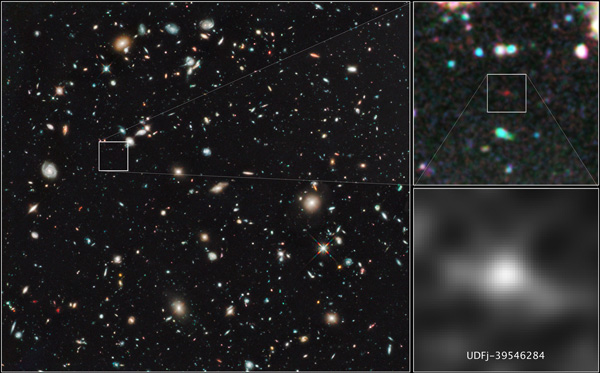
Hubble Finds Most Distant Galaxy Candidate
Astronomers have pushed NASA's Hubble Space Telescope to its limits by finding what is likely to be the most distant object ever seen in the universe. The object's light traveled 13.2 billion years to reach Hubble, roughly 150 million years longer than the previous record holder. The age of the universe is approximately 13.7 billion years.
The tiny, dim object is a compact galaxy of blue stars that existed 480 million years after the big bang. More than 100 such mini-galaxies would be needed to make up our Milky Way. The new research offers surprising evidence that the rate of star birth in the early universe grew dramatically, increasing by about a factor of 10 from 480 million years to 650 million years after the big bang.
"NASA continues to reach for new heights, and this latest Hubble discovery will deepen our understanding of the universe and benefit generations to come," said NASA Administrator Charles Bolden, who was the pilot of the space shuttle mission that carried Hubble to orbit. "We could only dream when we launched Hubble more than 20 years ago that it would have the ability to make these types of groundbreaking discoveries and rewrite textbooks."
Astronomers don't know exactly when the first stars appeared in the universe, but every step farther from Earth takes them deeper into the early formative years when stars and galaxies began to emerge in the aftermath of the big bang.
"These observations provide us with our best insights yet into the earlier primeval objects that have yet to be found," said Rychard Bouwens of the University of Leiden in the Netherlands. Bouwens and Illingworth report the discovery in the Jan. 27 issue of the British science journal Nature.
This observation was made with the Wide Field Camera 3 starting just a few months after it was installed in the observatory in May 2009, during the last NASA space shuttle servicing mission to Hubble. After more than a year of detailed observations and analysis, the object was positively identified in the camera's Hubble Ultra Deep Field-Infrared data taken in the late summers of 2009 and 2010.
The object appears as a faint dot of starlight in the Hubble exposures. It is too young and too small to have the familiar spiral shape that is characteristic of galaxies in the local universe. Although its individual stars can't be resolved by Hubble, the evidence suggests this is a compact galaxy of hot stars formed more than 100-to-200 million years earlier from gas trapped in a pocket of dark matter.
"We're peering into an era where big changes are afoot," said Garth Illingworth of the University of California at Santa Cruz. "The rapid rate at which the star birth is changing tells us if we go a little further back in time we're going to see even more dramatic changes, closer to when the first galaxies were just starting to form."
The proto-galaxy is only visible at the farthest infrared wavelengths observable by Hubble. Observations of earlier times, when the first stars and galaxies were forming, will require Hubble's successor, the James Webb Space Telescope (JWST).
The hypothesized hierarchical growth of galaxies — from stellar clumps to majestic spirals and ellipticals — didn't become evident until the Hubble deep field exposures. The first 500 million years of the universe's existence, from a z of 1000 to 10, is the missing chapter in the hierarchical growth of galaxies. It's not clear how the universe assembled structure out of a darkening, cooling fireball of the big bang. As with a developing embryo, astronomers know there must have been an early period of rapid changes that would set the initial conditions to make the universe of galaxies what it is today.
"After 20 years of opening our eyes to the universe around us, Hubble continues to awe and surprise astronomers," said Jon Morse, NASA's Astrophysics Division director at the agency's headquarters in Washington. "It now offers a tantalizing look at the very edge of the known universe — a frontier NASA strives to explore."
Hubble is a project of international cooperation between NASA and the European Space Agency. NASA's Goddard Space Flight Center in Greenbelt, Md., manages the telescope. The Space Telescope Science Institute (STScI) conducts Hubble science operations. STScI is operated for NASA by the Association of Universities for Research in Astronomy, Inc., in Washington.
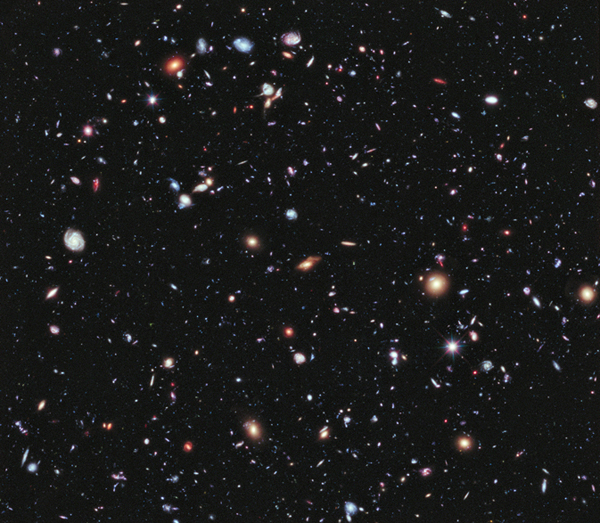
The Extreme Deep Field
Called the eXtreme Deep Field, or XDF, the photo was assembled by combining 10 years of NASA Hubble Space Telescope photographs taken of a patch of sky at the center of the original Hubble Ultra Deep Field. The XDF is a small fraction of the angular diameter of the full moon.
The Hubble Ultra Deep Field is an image of a small area of space in the constellation Fornax, created using Hubble Space Telescope data from 2003 and 2004. By collecting faint light over many hours of observation, it revealed thousands of galaxies, both nearby and very distant, making it the deepest image of the universe ever taken at that time.
The new full-color XDF image is even more sensitive, and contains about 5,500 galaxies even within its smaller field of view. The faintest galaxies are one ten-billionth the brightness of what the human eye can see.
 CosmicLight.com Home
CosmicLight.com Home